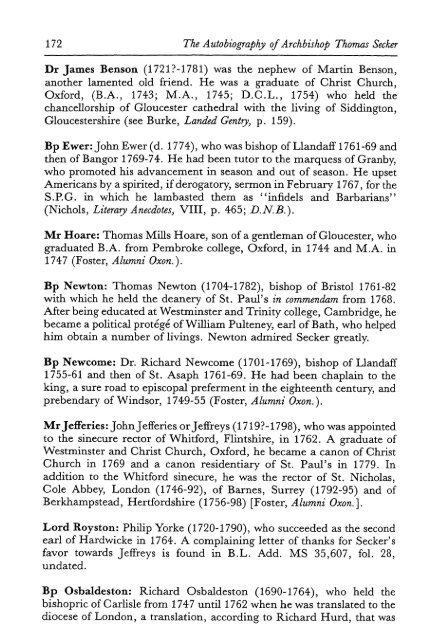Archbishop of Canterbury - KU ScholarWorks - The University of ...
Archbishop of Canterbury - KU ScholarWorks - The University of ...
Archbishop of Canterbury - KU ScholarWorks - The University of ...
You also want an ePaper? Increase the reach of your titles
YUMPU automatically turns print PDFs into web optimized ePapers that Google loves.
172<br />
<strong>The</strong> Autobiography <strong>of</strong> <strong>Archbishop</strong> Thomas Seeker<br />
Dr James Benson (1721?-1781) was the nephew <strong>of</strong> Martin Benson,<br />
another lamented old friend. He was a graduate <strong>of</strong> Christ Church,<br />
Oxford, (B.A., 1743; M.A., 1745; D.C.L., 1754) who held the<br />
chancellorship <strong>of</strong> Gloucester cathedral with the living <strong>of</strong> Siddington,<br />
Gloucestershire (see Burke, Landed Gentry, p. 159).<br />
Bp Ewer: John Ewer (d. 1774), who was bishop <strong>of</strong> Llandaff 1761-69 and<br />
then <strong>of</strong> Bangor 1769-74. He had been tutor to the marquess <strong>of</strong> Granby,<br />
who promoted his advancement in season and out <strong>of</strong> season. He upset<br />
Americans by a spirited, if derogatory, sermon in February 1767, for the<br />
S.P.G. in which he lambasted them as "infidels and Barbarians"<br />
(Nichols, Literary Anecdotes, VIII, p. 465; D.N.B.).<br />
Mr Hoare: Thomas Mills Hoare, son <strong>of</strong> a gentleman <strong>of</strong> Gloucester, who<br />
graduated B.A. from Pembroke college, Oxford, in 1744 and M.A. in<br />
1747 (Foster, Alumni Oxon.).<br />
Bp Newton: Thomas Newton (1704-1782), bishop <strong>of</strong> Bristol 1761-82<br />
with which he held the deanery <strong>of</strong> St. Paul's in commendam from 1768.<br />
After being educated at Westminster and Trinity college, Cambridge, he<br />
became a political protege <strong>of</strong> William Pulteney, earl <strong>of</strong> Bath, who helped<br />
him obtain a number <strong>of</strong> livings. Newton admired Seeker greatly.<br />
Bp Newcome: Dr. Richard Newcome (1701-1769), bishop <strong>of</strong> Llandaff<br />
1755-61 and then <strong>of</strong> St. Asaph 1761-69. He had been chaplain to the<br />
king, a sure road to episcopal preferment in the eighteenth century, and<br />
prebendary <strong>of</strong> Windsor, 1749-55 (Foster, Alumni Oxon.).<br />
Mr Jefferies: John Jefferies or Jeffreys (1719?-1798), who was appointed<br />
to the sinecure rector <strong>of</strong> Whitford, Flintshire, in 1762. A graduate <strong>of</strong><br />
Westminster and Christ Church, Oxford, he became a canon <strong>of</strong> Christ<br />
Church in 1769 and a canon residentiary <strong>of</strong> St. Paul's in 1779. In<br />
addition to the Whitford sinecure, he was the rector <strong>of</strong> St. Nicholas,<br />
Cole Abbey, London (1746-92), <strong>of</strong> Barnes, Surrey (1792-95) and <strong>of</strong><br />
Berkhampstead, Hertfordshire (1756-98) [Foster, Alumni Oxon.].<br />
Lord Royston: Philip Yorke (1720-1790), who succeeded as the second<br />
earl <strong>of</strong> Hardwicke in 1764. A complaining letter <strong>of</strong> thanks for Seeker's<br />
favor towards Jeffreys is found in B.L. Add. MS 35,607, fol. 28,<br />
undated.<br />
Bp Osbaldeston: Richard Osbaldeston (1690-1764), who held the<br />
bishopric <strong>of</strong> Carlisle from 1747 until 1762 when he was translated to the<br />
diocese <strong>of</strong> London, a translation, according to Richard Hurd, that was

















